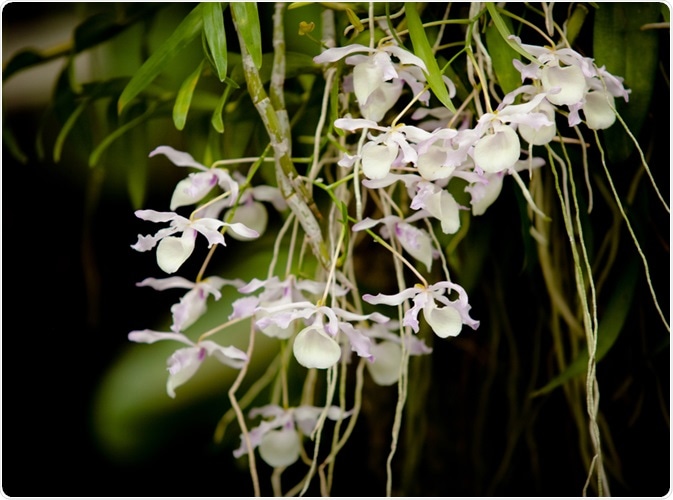
© Kitipong Phorka/Shutterstock.com
For thousands of years, people in southern China have risked their lives to pick the “immortality herb” grown at the edge of cliffs to treat critically ill patients. This herb is in fact a low-growing member of the orchid family called dendrobium. Commonly referred to as Shihu, it is highly regarded in traditional Chinese medicine as a treatment for many ailments, including fever, tuberculosis, inflammation, dyspepsia and cancer. It is also used as a tonic to protect eyesight, improve appetite and digestion and promote longevity.
There is consequently much interest in determining the potential of using dendrobium in the development of novel pharmaceuticals.
Dendrobium
Dendrobium is a species of orchid that grows across many areas of China1. Around 30 of the 78 varieties of dendrobium have been widely used in China for centuries as ingredients for drinks or soup to promote good health2. Furthermore, dendrobium has demonstrated impressive medicinal activity. Clinical studies have shown that it boosts the immune system and helps the body fight infections, including Helicobacter pylori and tuberculosis, and restores elevated blood sugar levels to within the normal range. In a study of 172 patients with chronic pharyngitis, treatment with a dendrobium-based remedy cured 62 cases and improved a further 87 cases3.
One of the more common species D. devonianum exhibits high yield and quality. Due to its anti-tumour and antioxidant activities, much research has been focussed on the bioactive components of this plant1. However, one of the most abundant components in dendrobium plants—polysaccharides—have received little attention despite them providing its immuno-stimulatory activity4.
It is known that the bioactivities of polysaccharides are closely correlated with their chemical properties, such as molecular size, constituent monosaccharides, conformations, and glycosidic linkages5. Such information regarding the polysaccharides of D. devonianum are sparse6.
Characterising polysaccharides from D. devonianum
A recent study investigated the structural features and chemical properties of polysaccharides from D. devonianum7. In addition, the immunomodulatory activity of the polysaccharides were evaluated in a macrophage model.
1H and 13C nuclear magnetic resonance (NMR) spectra of the polysaccharide sample were obtained using a Bruker AVANCE™-400 NMR spectrometer and the molecular surface morphology was analysed using a Bruker BioScope™ Resolve atomic force microscope.
Results provided the molecular weights, polydispersity index, and radius of gyrations of D. devonianum polysaccharides. Application of the polymer solution theory revealed that the D. devonianum polysaccharide existed as a globular shape in aqueous solution, and this was confirmed by atomic force microscopy analysis7. The polysaccharide was almost free of branches and no molecular aggregation was apparent. The prevalent monosaccharide components of D. devonianum polysaccharide were mannose and glucose. The structure was characterized by β-1,4-D-Manp glycosidic linkages and substituted with acetyl groups at O-2 or O-3 positions on some mannosyl residues.
D. devonianum polysaccharide effectively promoted the immune functions of macrophages including nitric oxide release and phagocytosis. The authors postulated that the high mannose content of the D. devonianum polysaccharide may contribute to its immunomodulatory activity.
Such clarification of the chemical characteristics as well as the pharmacological activities of polysaccharide from D. devonianum will be helpful in better understanding of its structure-bioactivity relationship. Furthermore, the demonstration of the potential for D. devonianum to promote immunological activity supports further investigation into the value of producing D. devonianum as functional food or even pharmaceuticals.
References
- Sun J, et al. Natural Product Research 2014;28(21):1900–1905.
- Ng TB, et al. Applied Microbiology and Biotechnology 2012;93(5):1795–1803.
- Liao Ning Zhong Yi Za Zhi (Liaoning Journal of Traditional Chinese Medicine) 1992;3:31.
- Xing X, et al. Bioactive Carbohydrates and Dietary Fibre 2013;1(2):131–147.
- Ferreira SS, et al. Carbohydrate Polymers 2015;132:378–396.
- Tong L, et al. RSC Advances 2016;6(46):40250–40257.
- Deng et al. Carbohydrate Polymers 2018;180:238–245.
About Bruker BioSpin - NMR, EPR and Imaging

Bruker BioSpin offers the world's most comprehensive range of NMR and EPR spectroscopy and preclinical research tools. Bruker BioSpin develops, manufactures and supplies technology to research establishments, commercial enterprises and multi-national corporations across countless industries and fields of expertise.
Sponsored Content Policy: News-Medical.net publishes articles and related content that may be derived from sources where we have existing commercial relationships, provided such content adds value to the core editorial ethos of News-Medical.Net which is to educate and inform site visitors interested in medical research, science, medical devices and treatments.